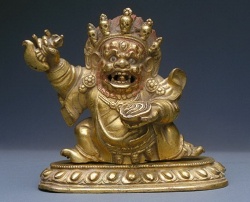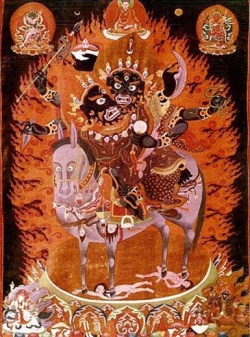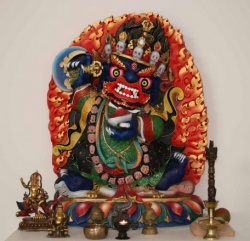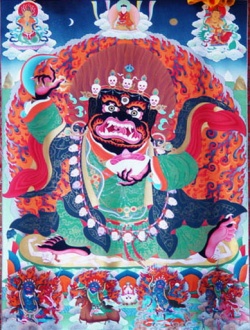Bernagchen
Click here to see other articles relating to word Bernagchen
by Jeff Watt
The two-armed Mahakala called Bernakchen is a protector of the Karma Kagyu school. Dorje Bernagchen (The Black Cloak two armed Mahakala) It is often thought to be the primary protector, but it is actually the main protector of the Karmapas specifically.This protective deity is is described as figures possessing stout bodies, short but thick and strong limbs. His flaming hair, decorated with a crown of skulls, rises from his forehead, while a circle of flames dance around him. His face possesses a typical wrathful expression. The mouth is contorted to an angry smile from its corners protrude long fangs. The protruding, bloodshot eyes have an angry and staring expression and usually a third eye is visible in the middle of the forehead.
Kubilai Khan succeeded his Buddhist brother Munga, and fearful of the influence of Karma Pakshi, the second Karmapa, had him confined to the Chinese Imperial Palace where he was tied by his beard (among other terrible ordeals.)
Karmapa prayed to Mahakala Bernagchen, but "Great Black Cloak" took so long putting on his boots, that by the time he got there, the ordeal had ended. However, as he had been summoned, he was obliged by rules of combat to cleave something with the hook-knife that he held at the ready. The Karmapa therefore had him strike the palace. As a result, there is still a gash somewhere in the Imperial Palace.
There is a version saying the Karmapa struck Mahakala for his tardiness, giving him his swollen face! Consequently, no subsequent Karmapa has ever worn a beard.
In his right hand, he holds a chopper, which symbolizes the cutting through of negative patterns such as aggression, hatred, and ignorance. In his left hand, he holds a skull cup, a ritual element typically filled with blood or human brain matter. He is seen standing on the corpse of two human bodies, thus symbolizing the death of negativities and the complete uprooting of negative patterns to such a point that, like a dead body, they will not come to life.
Tibetan: Bernag Chen
The fiercely wrathful, Black Cloak Mahakala is black in colour, with one face, three round bulbous eyes, a large gaping red mouth with bared white fangs, his yellow beard, eyebrows and hair flow upward like flames. The right hand holds aloft a curved flaying knife with a vajra handle. The left holds a white blood filled skullcup to the heart. Adorned with a crown of five dry white skulls, earrings, bracelets and a garland of freshly severed heads, he wears a great black cloak with a green jacket beneath. He stands surrounded by black smoke and faint red licks of the flames of pristine awareness.
At the top center of the composition is an unidentified Karmapa, the Black Hat Lama of the Kamtsangpa .Tradition of Tibetan Buddhism. He is very likely to be the 11th Karmapa, a teacher of Situ Panchen Chokyi Jungne. To the right is the female meditational deity Vajravarahi, red in colour, holding a curved knife in the upraised right hand and a skullcup in the left with a katvanga staff leaning against the left shoulder. She stands in a dancing posture. Below Karmapa on the left is a protector of the world, the Guardian of the Northern Direction, Vaishravana, wearing the helmet and armor of a king. He has one face and two hands holding a conical banner and a mongoose spewing jewels; riding atop a lion. On the right is Karnag Dorje Gyalpo a naga with a hood of snakes above the head and lower body in the shape of a serpent. The two hands hold a wish-fulfilling jewel.
At the right side of Mahakala is Shri Devi Dudsolma, black, with one face and four hands holding a vajra peg (kila) katvanga staff and a skullcup and mirror. She rides atop a donkey. On the left side of Mahakala is Damchen Garwa Nagpo, the oath-bound blacksmith, with one face and two hands holding a blacksmith's hammer and a bellows. He rides atop a brown goat.
Arranged below the central figure are three more wrathful attendant figures in the retinue of the Black Cloak Mahakala. At the left is Trakshe, a fearsome figure who stands with a female consort at the side. In the middle is Tsogdag, a black male naga with a hood of snakes, riding atop an elephant. At the right the male attendant, Shingkyong, with a lion face rides atop a black horse clutching a spear in the right hand and a skullcup with wrathful food offerings (torma) in the left. Shingkyong is often accompanied by a male and female monkey. One monkey can just be discerned standing behind Shingkyong and staring forward.
Bernag Chen was introduced into the Karma Kagyu School by the 2nd Karmapa, Karma Pakshi (1206-1283). The practice originated from the Revealed Treasure (Tibetan: ter ma) tradition of the Nyingma School.
Lineage: Dagnyi Heruka, Chog Drup Arnapa, Mal Lotsawa Lodro Drag, Nyal Nyima Bar, Nyal Jose, drogon Rechen, Gyalse Pomdragpa, Karma Pakshi, etc.
The style of painting is 'black scroll' (Tibetan: nag tang). The figures are drawn in outline on a black canvas and filled with colour and details as desired.
rdo rje ber nag can, the black cloaked one, he is the main protector of the Karma Kagyu lineage.
Bernagchen and the Karmapa are inseparable. From Karma Pakshi onwards Mahakala has protected all the Karmapa Lineage. The Karmapas are renowned for performing the protector Mahakala dance in preparation for the New Year. The previous 16th Karmapa performed the dance only once after he left Tibet, though not in traditional costume, and that was soon after he came to Sikkim in the 60′s.
February 20th, 2012 was the first time a Karmapa has performed the dance in India. The entire assembly in the theater at Tergar stilled as His Holiness embodied Mahakala , as if sliding into another form while at the same time being fully the Karmapa. The fluidity of movement displaying the inseparability of appearance and emptiness, was riveting. It was a state which seemed beyond meditation.
At the end of the Black Hat Dance there is a crescendo as the Karmapa takes out a bow and arrow, seemingly aimed to subdue evil. This reminded me of an episode in Tibetan history when Pal Dorji, one of the 25 disciples of Guru Rinpoche, donned a black costume and killed the evil king who was destroying the dharma. It was an utterly arresting moment when theatre and ritual come alive. Was life imitating art, or art imitating life?
Mary Jane Bennett, a disciple of the 16th Gyalwa Karmapa for the last forty years, described it as “the most incredible experience of my life as a Tibetan Buddhist.
“I was present at the last Losar at Rumtek Monastery before the 16th Karmapa passed into parinirvana. Over the years I’d always loved the Mahakala puja, but I never appreciated the Lama dance. Now all that has changed.
“The setting was majestic. Mount Kailash had been painted as a backdrop at the Monlam pavilion. Descending in stages leading down to the area where the dances were held was a statue of the Buddha, below it a statue of Dusum Khyenpa, and then the 16th Karmapa statue, lined up with the 17th Karmapa’s seat. The Mahakala statues formed a backdrop on the base of the stage just in front of His Holiness’ seat. “And then His Holiness came out to dance. The power of his presence and his first movements took my breath away.
“The day went on and on but time was eclipsed. Each performance was perfection Close to the end, when the torma was taken out, the dance was so choreographed….even the best theatre troope in the world could not have done better.
“After two awe inspiring days, I am reminded of what the 16th Karmapa said to me when he was already ill and dying.. ‘Don’t be sad; the next Karmapa will be born in Tibet but will speak many languages. His activity will be vast and spread throughout the world. He will be far greater than me.”
In some books, you call the deity Mahakala, or Bernagchen in Tibetan, Black Coat. In the Kanjur and Tenjur, which are only found in Tibetan since the Sanskrit versions have disappeared, you can find information about Mahakala. Mahakala is Sanskrit. If you look up the tantra of Mahakala in the index under Gompo Bernagchen, you’d also find it. However, you would never find it in the Kanjur under the name, Black Coat.
In general, the instructions we give in the lectures are rather brief and short. The great masters had written down the main and comprehensive explanations in text. The masters were themselves, ‘professionals’ who specialized in certain yidam, or Dharma protector practices. Their instructions to these practices can be found in the sections of the main texts on the different tantras within the Kanjur and Tenjur. You could find them by searching in the index.
In the future, if ever someone wrote a book misconstruing Mahakala, then you could always reference the original or source explanations to check it, and for clarification. But you have to use the proper name, and not Black Coat. The English is actually a correct translation of the meaning of Bernagchen, but don't use it. What kind of coat would westerners imagine when they hear the word, coat? The western coat is a different style than the Tibetan coat called döthung. People will therefore have a wrong concept about what Mahakala is wearing. He is actually wearing a ber, which looks very different from a normal coat. The English reference is thus defective in its representation, and gives the wrong impression.



